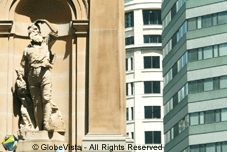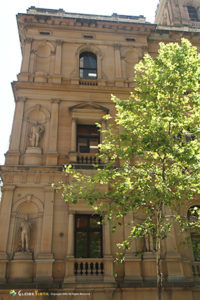Lands Department Building Statues

Public Art: Lands Department Building statues
Sculptors: © Tommaso Sani, James White, Alexander Sherrif, Nelson Illingworth and W.P. MacIntosh.
Date: c.1891
Description: High on the ledges of the Lands Department building silently stands the 24 sandstone carved figures of legislators, explorers and botanists of Australia. Note that each statue has one foot placed forward.
Location: The statues are located on the exterior niches of the Land Department Building, Bridge Street, Sydney, Australia.
The Statues: On the Bridge Street facade you will find Matthew Flinders, Hamilton Hume, Sir Joseph Banks, Charles Sturt, Arthur Phillip, William Wills, George Bass, Robert O’Hara Burke, William Hovell, John Oxley, Ludwig Leichhardt, and Sir Thomas Mitchell. On the Bent Street facade are Allan Cunningham, Sir John Robertson, Gregory Blaxland, Sir William Charles Wentworth, William Lawson, and James Farnell. On the Gresham, Street facade are, Sir Henry Parkes, Sir James Martin, Daniel H Deniehy, and Sir George Grey. On the Loftus Street facade, stand John Macdouall Stuart and James Meehan.

History of the Lands Department Building: The Lands Department building is one of the most fascinating historical buildings in Sydney’s CBD. It was designed by Sydney’s great public architect James Barnet in 1876.
The first stage of the Department of Lands Building was built between 1876 and 1881 and the second stage between 1888 and 1892. Strangely the foundation stone was laid on the 7th of October, 1876 but to this day no one has been able to find its location.
In March 1890 Sir Henry Parkes asked Barnet to nominate the names of the 48 men who should be worthy enough to grace the niches with a statue. Some of the listed were rejected on the grounds that there were “more enterprising colonists than explorers”.
In the end only 23 of the 48 niches had been allocated statues when work stopped in 1901 due to the Depression of the 1890s. It was also recommended that the other niches remain empty to commemorate future generations who might be worthy of a place on the building.
It wasn’t until 2010, 109 years since the last statue was placed in the niche was a new one added, that of James Meehan.
Italian sculptor Tommaso Sani was commissioned to produce the statues of Allan Cunningham, W.C. Wentworth and Sir John Robertson.
Controversy: Sculptor Tomaso Sani was commissioned by the premier of the time to carve a sandstone bust of James Barnet for the building in recognition of his achievements but the new Secretary of Public Works sneakily swapped the name of Barnet to Sir John Robertson.
So Who Was James Barnet?: James Johnstone Barnet (1827-1904) was born in Scotland and as a young lad studied drawing, design and architecture in London. In 1854 James and his wife Amy decided to start a new life in Australia. They packed up their possessions and arrived in Sydney. A few years later Barnet joined the Colonial Architects office. Five years later in 1865 he became New South Wales Colonial Architect.
Things you may not know about James Barnet
He was the first architect to install a telephone in a government office (what a mistake that was!).
In his career Barnet designed 169 post and telegraph offices, 130 courthouses, and several hundred public buildings throughout New South Wales.